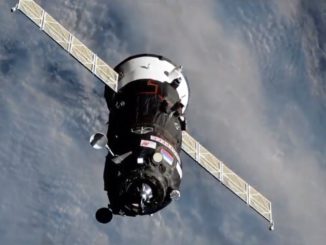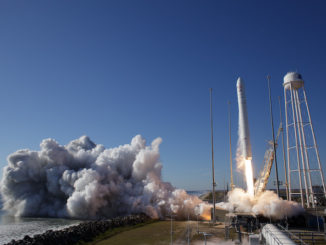A modified version of Russia’s Soyuz rocket launched Friday from the Plesetsk Cosmodrome, a spaceport on the edge of the Russian Arctic, with a military satellite whose mission is shrouded in mystery.
The Soyuz 2-1v rocket lifted off at 1804 GMT (3:04 p.m. EDT; 9:04 p.m. Moscow time) from Pad 4 at Site 43 at Plesetsk, a military-run spaceport around 500 miles (800 kilometers) north of Moscow in Russia’s Arkhangelsk region.
Russia announced the successful launch in a statement posted on the Russian Defense Ministry’s website late Friday.
The defense ministry and Russian media reports did not offer any immediate details on the payload launched Friday.
U.S. military tracking data indicated the spacecraft and the Soyuz rocket’s Volga upper stage were orbiting about 410 miles (660 kilometers) above Earth following Friday’s mission. The objects are flying in an orbit tilted 98 degrees to the equator.
Officially designated Kosmos 2519, the satellite might be the first of several “14F150 Napryazhenie” geodetic satellites designed to make extremely accurate measurements of Earth’s shape and gravitational field. Such data that can be fed into ballistic missile guidance computers, according to RussianSpaceWeb.com, a website run by respected Russian space journalist Anatoly Zak.
The launch was not officially announced in advance, but Russian authorities issued warnings to pilots a few days before the flight to keep out of drop zones in the Arctic Ocean where the Soyuz 2-1v’s first stage and payload fairing were predicted to fall.
The Soyuz 2-1v flew north from the Plesetsk Cosmodrome, its first stage driven by an NK-33 main engine and four steering thrusters.

The lightweight rocket is a scaled-down version of Russia’s venerable Soyuz launcher, but it employs a different propulsion system. The single-nozzle NK-33 engine replaces the four-nozzle RD-108 engine on the Soyuz main stage.
The Soyuz 2-1v also flies without the four strap-on boosters that make up the first stage of other Soyuz vehicles.
The NK-33 engine came from a stockpile of Soviet-era rocket engines manufactured more than 40 years ago for Russia’s huge N1 moon rocket. Russia’s Kuznetsov Design Bureau, which built the NK-33 engines, kept them in storage after the Soviet Union canceled moon program.
Russia exported some of the NK-33 engines to the United States in the 1990s for Aerojet to sell to U.S. launch providers. Orbital ATK purchased the modified NK-33 engines — called the AJ26 by Aerojet Rocketdyne — to use on its Antares launcher for International Space Station resupply missions.
One of two NK-33 engines failed seconds after an Antares launch from Virginia in October 2014, destroying the rocket and a Cygnus supply ship heading for the space station.
Orbital ATK ordered replacement engines from Russia and redesigned the Antares to accommodate the new propulsion system. The new engines are RD-181s, similar to the highly successful RD-180 engine used on United Launch Alliance’s Atlas 5 rocket.

Meanwhile, Russian engineers designed an upgraded combustion chamber and a new igniter chamber for installation on the leftover NK-33 engines to fly on future Soyuz 2-1v rockets.
An NK-33 engine with the new chambers passed a ground acceptance test in October 2015, one year after the Antares failure, and the powerplant performed well on a Soyuz 2-1v launch in December 2015.
The Soyuz 2-1v’s second stage, powered by an RD-0124 engine, is similar to the third stage of the Soyuz 2-1b rocket often used for launching Russian military satellites, plus international commercial payloads from French Guiana.
A Volga upper stage was expected to maneuver the mission’s classified satellite into its final perch a few hundred miles above Earth.
Friday’s launch was the third flight of a Soyuz 2-1v booster. Including Friday’s flight, two of the missions have been successful, while one of the launches was a partial success after failing to deploy one of its payloads upon reaching orbit.
Email the author.
Follow Stephen Clark on Twitter: @StephenClark1.



